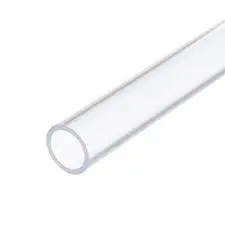Sep . 25, 2024 01:55 Back to list
cpvc tube
Understanding CPVC Tubes A Comprehensive Overview
CPVC, or Chlorinated Polyvinyl Chloride, is a type of thermoplastic polymer widely utilized in various plumbing and industrial applications. Its composition makes it an excellent choice for both hot and cold water systems, as well as for chemical transportation. The unique properties of CPVC tubes have contributed to their growing popularity in the construction and manufacturing industries.
Properties and Advantages of CPVC Tubes
One of the most notable features of CPVC tubes is their ability to withstand high temperatures. CPVC can handle water temperatures up to 200°F, making it suitable for hot water systems where traditional PVC might not perform adequately. This thermal resistance is essential in many applications, from residential plumbing to commercial facilities.
Furthermore, CPVC is highly resistant to corrosion, which is a significant advantage over metal piping systems. In environments where water quality may vary, CPVC does not rust or corrode, ensuring a longer lifespan and lower maintenance costs. This characteristic makes CPVC tubes an ideal choice for transporting drinking water, as they do not leach harmful chemicals into the water supply.
Another significant benefit of CPVC is its resistance to various chemicals. This makes it an excellent option for industries that require the transport of corrosive substances. CPVC is compatible with many chemicals, including acids and bases, enabling it to meet the needs of chemical processing and manufacturing applications.
Installation and Cost-effectiveness
cpvc tube

Installation is another area where CPVC tubes shine. They are lightweight compared to metal pipes, which makes them easier to handle and install. Additionally, CPVC piping does not require welding, as it can be joined using solvent cement. This simplifies the installation process, reduces labor costs, and minimizes the potential for installation errors.
From a cost perspective, while the initial price of CPVC may be slightly higher than that of PVC, the long-term savings associated with maintenance and replacement make CPVC a more economical option in the long run. Its durability means fewer repairs, and its resistance to corrosion and chemicals leads to lower overall operational costs.
Applications of CPVC Tubes
The applications of CPVC tubes are diverse. In residential settings, they are commonly used for home plumbing systems, hot water lines, and drainage systems. For commercial buildings, CPVC is employed in a variety of HVAC applications, where its thermal stability is crucial.
Industrially, CPVC is pervasive in chemical processing plants, wastewater treatment facilities, and food processing units, owing to its reliability in transporting various fluids without the risks associated with metal pipe corrosion.
Conclusion
In conclusion, CPVC tubes represent a modern solution to many plumbing and piping challenges faced in both residential and industrial applications. Their ability to handle high temperatures, resist corrosion, and transport chemicals safely makes them a preferred choice among engineers and contractors. As industries continue to evolve and demand more efficient, durable, and cost-effective materials, CPVC tubes are likely to play an increasingly vital role in shaping the future of piping systems. As technology advances and more innovations are introduced into the manufacturing process, CPVC will remain at the forefront of plumbing solutions, delivering quality and reliability across various applications.
-
High-Quality PPR Pipes and Fittings Durable ERA PPR & PVC PPR Solutions
NewsJul.08,2025
-
Black HDPE Cutting Board - Durable, Non-Porous & Food Safe HDPE Plastic Cutting Board
NewsJul.08,2025
-
High-Quality CPVC Panel Durable HDPE & PVC Panels Supplier
NewsJul.08,2025
-
Double PE Welding Rod Supplier - High Strength, Durable & Versatile Welding Solutions
NewsJul.07,2025
-
High-Quality PVC-O Pipe Supplier Durable 75mm PVC Pipe & Connections Leading PVC Pipe Company
NewsJul.07,2025
-
HDPE Drainage Pipe Supplier – Durable & Corrosion-Resistant Solutions
NewsJul.06,2025

